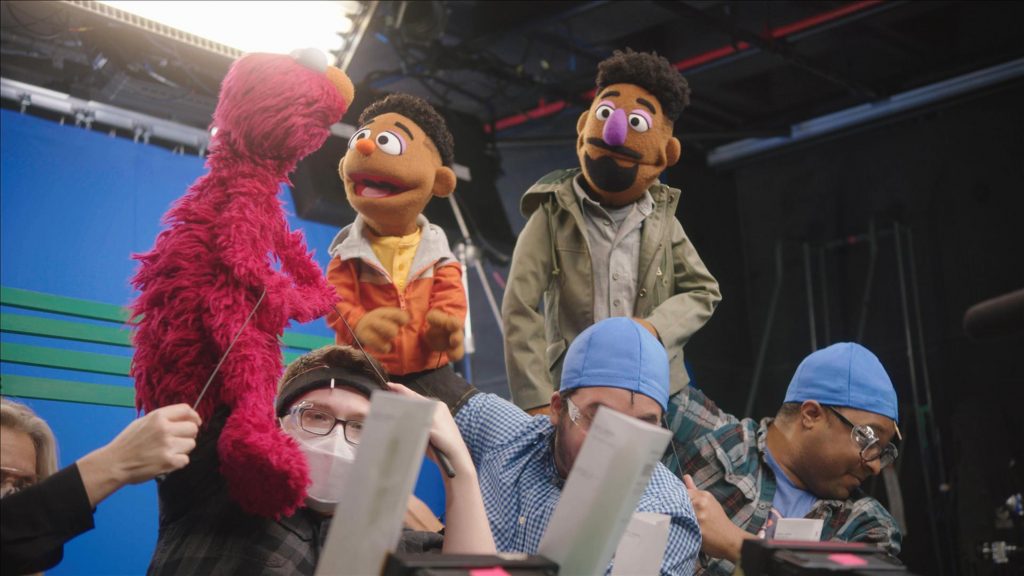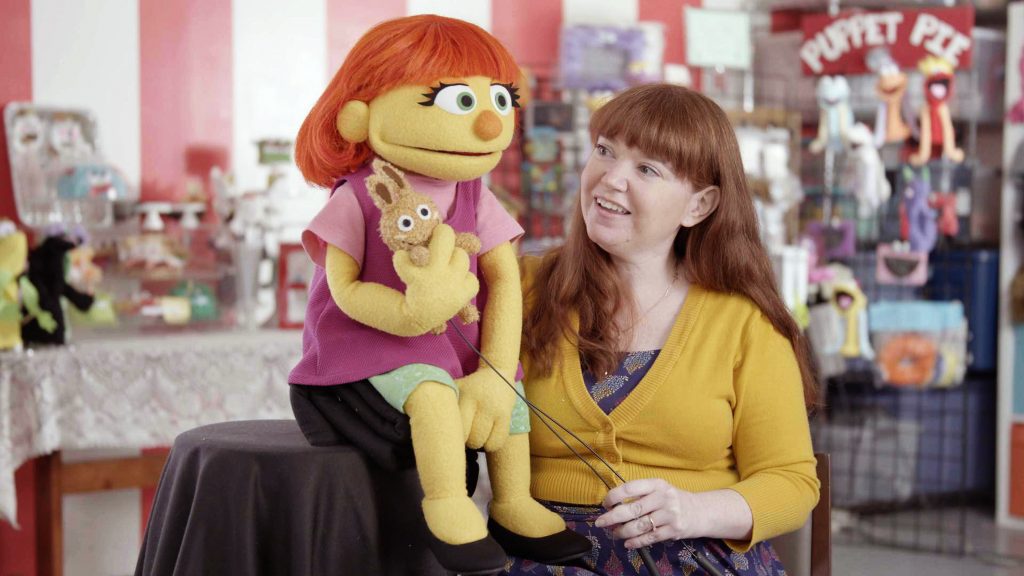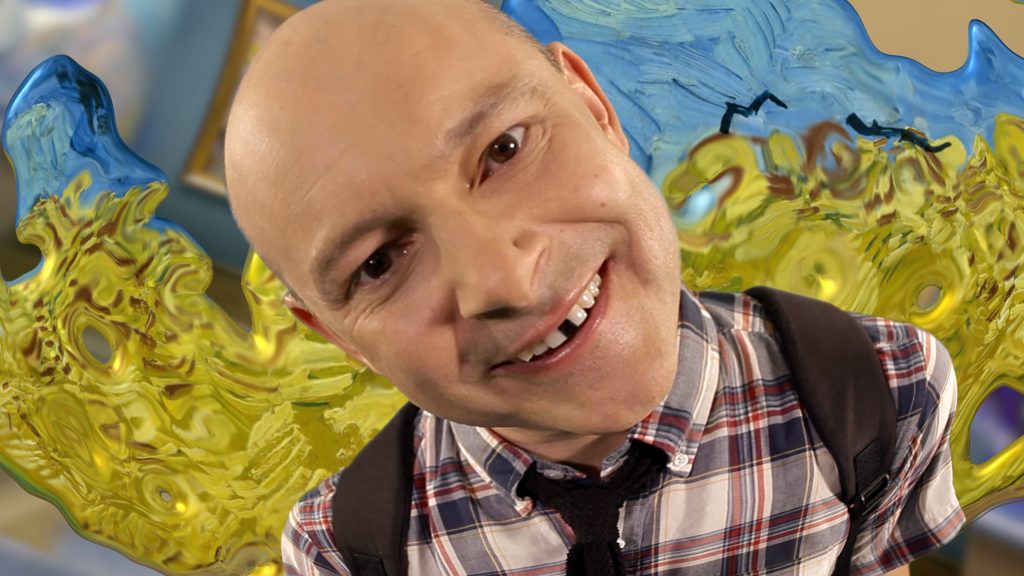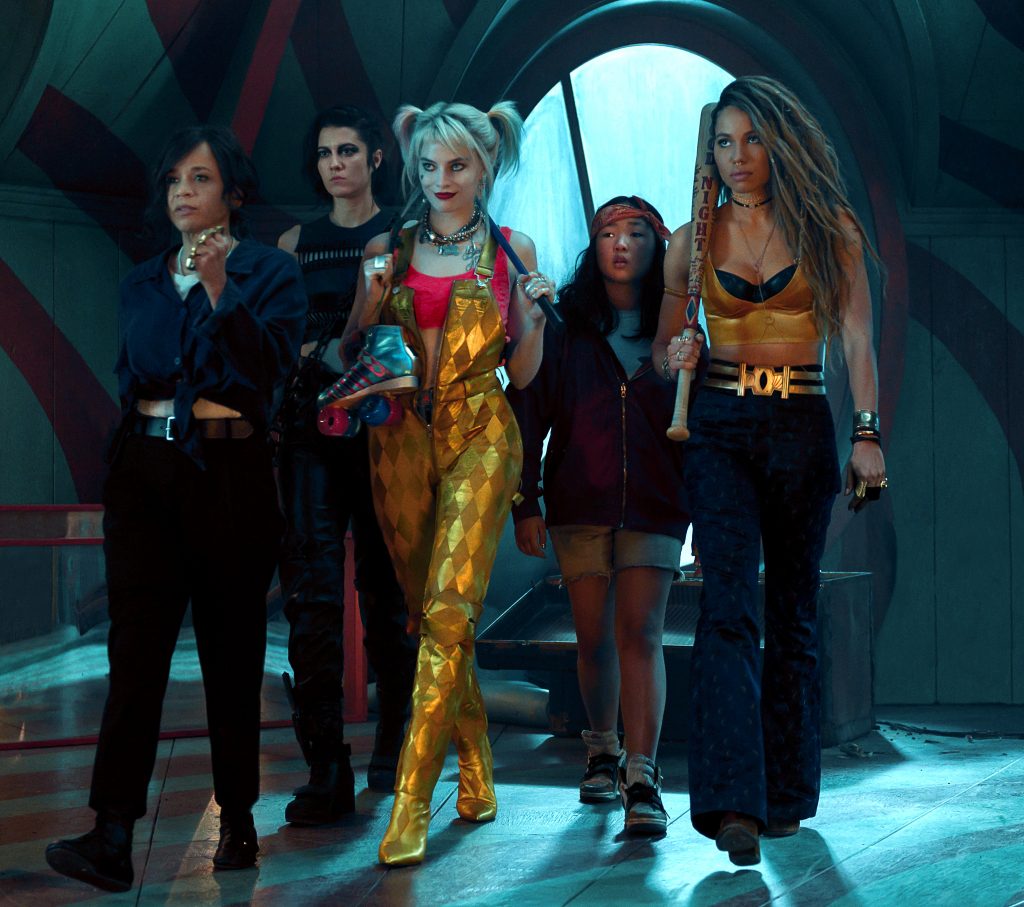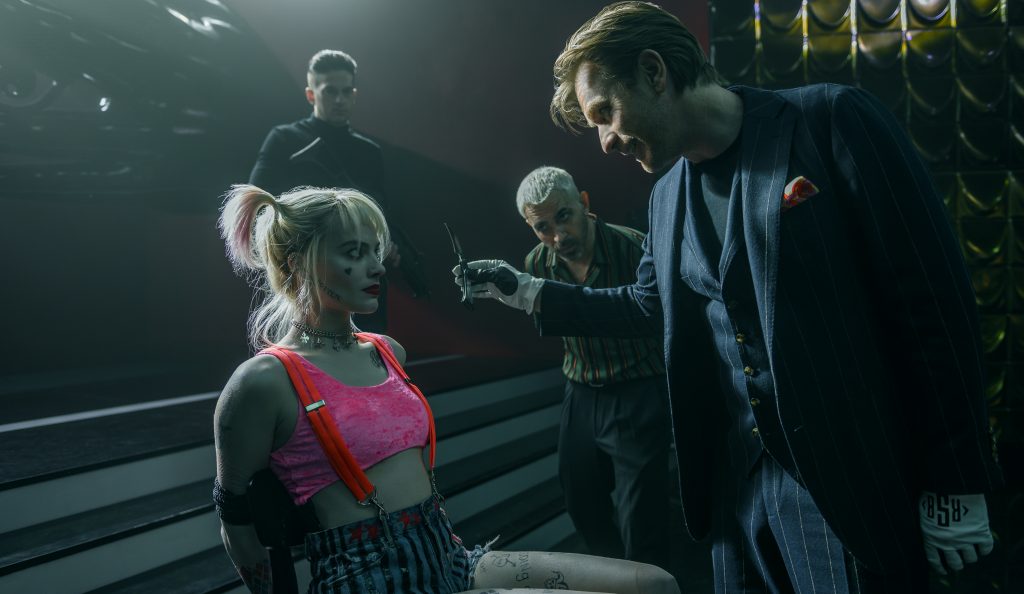November 9, 2021
by Carla Hay

Directed by Walt Becker
Culture Representation: Taking place in New York City, the live-action/animated film “Clifford the Big Red Dog” features a predominantly white cast of characters (with some African Americans, Asians and Latinos) representing the working-class, middle-class and wealthy.
Culture Clash: A 12-year-old girl’s stray puppy, which has an unusual red color, grows into a gigantic dog overnight, and she has conflicts with authority figures who want to take the dog away from her.
Culture Audience: Besides appealing to the obvious target audience of “Clifford the Big Red Dog” cartoon fans, this movie version of the TV series will appeal primarily to people who don’t mind watching predictable family films with a dull storyline and bland characters.

With not enough imagination and too many boring clichés, “Clifford the Big Red Dog” clumsily stumbles around more than this elephant-sized dog does in his New York City apartment. This is the first feature film based on Norman Bridwell’s “Clifford the Big Red Dog” children’s books series, which have also been turned into two separate animated TV series. Unfortunately, this franchise’s first movie (which is a combination of live-action and animation) is an embarrassing dud, with almost nothing that’s worthy of its cinematic format. It looks like a lazily conceived TV special, but with a movie studio budget that’s wasted on dull stupidity.
Directed by Walt Becker, “Clifford the Big Red Dog” was written by Jay Scherick, David Ronn and Blaise Hemingway in such a by-the-numbers way, it seems like a computer could’ve programmed this script and probably done a better job. The jokes fall flat, the characters are forgettable, and the plot is so unadventurous and maudlin, you wonder why it took three people to come up with such a drab screenplay. The filmmakers also made the mind-boggling, bad decision to not have the dog Clifford talk in the movie, as the dog does in the animated TV series. Not giving Clifford the ability to talk erases any personality through spoken dialogue that the dog might have had in the movie, which will surely disappoint many fans.
The basic plot of the movie “Clifford the Big Red Dog” is that a 12-year-old girl named Emily Elizabeth Howard (played by Darby Camp), who lives in an apartment in New York City’s Harlem neighborhood, has a stray puppy whose fur is an unusual color: fire-engine red. She names the dog Clifford, and is told that she’s only allowed to keep him for one night. She wakes up the next morning to find that the dog has grown to be about 10 feet tall. Some hijinks ensue, as Emily tries to hide Clifford and tries to prevent people from taking the dog away from her.
But these hijinks have no real creativity and have been seen and done in many other movies where a child is trying to hide a secret and unusual companion that is in danger of being exploited and taken away for scientific experiments or for greedy business reasons. Everything in this movie is so predictable and with such mediocre visual effects, it’s almost offensive that this substandard project was given the budget of a feature film from a major movie studio.
And because Clifford doesn’t talk in this movie, the dog just does basic, run-of-the-mill things that dogs do. The filmmakers instead made the awful decision to make the comedy focused on Emily’s annoying and irresponsible uncle Casey (played by Jack Whitehall), who doesn’t particularly like the dog. Casey’s lines of dialogue are tepid or just downright cringeworthy. It tells you what you need to know right there about this dreck: A movie called “Clifford the Big Red Dog” just makes the dog a giant CGI prop to an irritating human being.
Emily lives with her single mother Maggie Howard (played by Sienna Guillory), a paralegal who’s stressed-out due to financial problems. Maggie is heavily in debt, and she’s barely making ends meet on her salary. Maggie often has to travel away from home when her boss does work outside the area. (Emily’s father is not seen or mentioned in the movie.) And so, in addition to having financial woes, Maggie feels guilty about not being there for Emily as much as Maggie would prefer.
When Maggie is away on business, she has a trusted person look after Emily. And this time around, because Maggie can’t find anyone else on such short notice, she reluctantly asks her younger brother Casey to look after Emily while Maggie is away for a few days. Casey, who’s about 10 to 15 years younger than Maggie, hasn’t told his sister that he’s currently homeless and living in a moving truck.
Casey is the type of flake who shows up 45 minutes late for a job interview at a place called Kerner Comics & Design, where he had hoped to work as an illustrator. Needless to say, because of his tardiness, Casey doesn’t even make it past the reception area because he blew his chance for the interview. Before he leaves, he takes some free candy in the reception area and mumbles something about how this candy is his dinner for the day.
Casey is homeless because he and his live-in girlfriend broke up, and his student debts have made him unable to afford his own place. (The movie never bothers to mention anything else about Casey’s college education to explain why his student loan debts are his biggest expenses.) Casey is first seen in the movie trying unsuccessfully to talk his way out of a parking ticket. Instead of taking the ticket, he ends up running away from the parking enforcement officer.
Casey and Maggie’s family history is briefly mentioned much later in the movie. They were both born in England, but their family moved to the United States when Casey was 2 years old, which is why he doesn’t have a British acccent. (Whitehall is British in real life though.) Maggie and Casey’s mother died when Casey was still underage. Their dad “fell apart” (Casey’s words) after his wife died, so it was up to Maggie to raise Casey. She gave up a chance to go to Oxford University (where she had a scholarship) because she had these guardian responsibilities.
Meanwhile, Emily is in sixth grade at an elite private school, where she attends on a scholarship. Predictably, she’s bullied at school by a clique of snobby “mean girls,” who ridicule Emily with the nickname Food Stamp because they think Emily is so poor, her family must be getting food stamp welfare from the government. Emily is a sensitive and compassionate child who already feels like an outsider because she’s new to the school, having recently relocated with her mother from upstate New York.
In the beginning of the movie, Emily is seen going around the neighborhood to collect recyclable cans for a fundraising drive at her school. It’s just a reason for viewers to see other people who clutter up the story, just so the movie can have a certain number of adults who can later react to seeing gigantic Clifford walking around the neighborhood. The supporting characters in this movie are very generic and have uninspired lines of dialogue.
The neighborhood supporting characters include Packard (played by David Alan Grieri), the cranky superintendent of the building where Emily and Maggie live; Raul Sanchez (played by Horatio Sanz) and Alonso Sanchez (played by Paul Rodriguez), two brothers who own and operate a bodega; Malik (played by Russell Peters), who works in a convenience store; and married attorney couple Mr. Jarvis (played by Keith Ewell) and Mrs. Jarvis (played by Bear Allen Blaine). They all contribute to Emily’s haul of recycled cans.
Casey tries to be responsible when taking care of Emily, in an attempt to make up for mistakes he made in the past when she was under his care. One day, while they’re strolling through a nearby park, they see an animal rescue tent called Bridwell’s Animal Rescue. Emily asks Casey if they can go inside. He tells her yes, but only on the condition that she knows that they can’t take home any of the pets.
The tent on the inside actually looks like a dark Victorian parlor that has some dogs and cats, but they’re outnumbered by wild animals that could be at a zoo. They include creatures such as a sloth, a chameleon and an animal that looks like a baby giraffe. Emily and Casey are greeted by Bridwell (played by John Cleese), the owner who has a mysterious aura about him.
Bridwell steers Emily to take a look at an unusually red stray puppy that he recently found. It’s shown in the movie’s opening scene that this puppy was born into a stray family of yellow Labrador retrievers in a warehouse. His mother and siblings were taken away by workers at a local dog pound, while the red puppy, which wasn’t seen by the workers, was left behind. The puppy escaped into the streets, where Bridwell found him.
Emily immediately adores the puppy and wants to take it home, but Casey is firm in telling her that she can’t have the dog because dogs aren’t allowed in the apartment building. He also knows that Maggie wouldn’t approve of having a dog anyway. “How big is he going to get?” Emily asks Bridwell of this puppy. Bridwell answers, “That depends on how much you love him.”
When she’s at home in her bedroom, Emily can’t find any information about Bridwell’s Animal Rescue on the Internet. But what do you know: Emily finds the puppy has mysteriously ended up in her backpack. Casey allows her to keep the dog, but only for that night. She names the dog Clifford, because that’s the first name the dog responds to in a positive way.
At school, Emily brings a giant plastic bag filled with the recycled cans that she collected. The “mean girls” leader Florence (played by Mia Ronn) and her two sidekicks Isabelle (played by Madison Smith) and Melinda (played by Madison Morris) scoff at Emily and tell her that their parents just wrote checks for the fundraiser. Meanwhile, a fellow student named Owen Yu (played by Izaac Wang), who has a secret crush on Emily, notices that Emily is being ridiculed, so he tries to make her feel better by telling her that it’s admirable that she went to the trouble of collecting recyclables to raise money.
Emily brings her plastic bag into the classroom. The contents accidentally spill out, and many of the students laugh at her. Someone recorded the incident on a phone, and the video goes viral. At home that night, Emily is crying in her bed while holding on to Clifford. Before she goes to sleep, she tells Clifford: “I wish you were big and strong and the world couldn’t hurt us.” Just at that moment, it’s raining outside, and Bridwell is standing on the street outside her building, as if he can hear Emily’s wish.
You know what happens next: Emily wakes up and sees that Clifford is no longer a small puppy and is now a dog that’s 10 feet tall. She’s startled at first but gets over it quickly. By contrast, Casey is thoroughly freaked out. And just at that moment, the building superintendent Packer is coming over to the apartment to fix a plumbing problem. Then there’s the expected frantic rush to hide Clifford.
One of the biggest problems with “Clifford the Big Red Dog” is how most people’s reactions to seeing this giant dog are unrealistically calm. People react with curiosity, with some taking out their phones to film or take pictures of the dog. There aren’t as many panicked reactions as there should have been, which would’ve made this film a lot funnier.
For example, there’s a scene that takes place shortly after Clifford becomes a giant dog. Clifford sees a man walking in a giant plastic bubble in the park, so Clifford runs after the bubble, like a dog that wants to fetch a ball. The man inside is terrified, but most of the people in the park just stare at this dog causing terror. It’s not the way most people would really react, which is to run away from the sight of a giant dog and call for help.
The reaction from the authorities is also toned-down. There’s some effort to find the dog, but it’s not on the level of the dog being seen as a monstrous freak that needs to be captured. No military units are deployed, and New York City doesn’t go on lockdown for people’s safety. Clifford also shows up in Emily’s classroom, and the dog makes her popular with most of the students. Viewers of this movie will have to to assume this story takes place in an alternate world where people occasionally expect to see giant animals walking through New York City.
In fact, the only time that Clifford really seems in danger of being captured is when the corrupt president/CEO of a genetic engineering firm named Lyfegro finds out about Clifford. Lyfegro does scientific experiments on animals to find out how to grow large crops of food, in order to ease world hunger. Lyfegro’s greedy leader is named Zack Tieran (played by Tony Hale), who keeps genetically modified animals at his company lab. (For example: a two-headed sheep.) He doesn’t really care about world hunger or animals. He just wants to get rich.
All of the scenes involving Lyfegro are convoluted aspects of the plot, which should’ve just stuck to Clifford being hunted for capture by military or law enforcement, because it’s unsafe for a giant animal of this size to be walking around any area that’s populated with humans. There’s a very phony-looking press conference with Police Chief Watkins (played by Ty Jones), where he urges the public, “If you see something, say something,” as if this giant dog is the equivalent of a suspicious package.
Owen and Emily predictably get to know each other better and become closer. Owen’s father Mr. Yu (played by Russell Wong) also becomes part of the story because he’s a wealthy businessman who comes up with an idea for this situation when Clifford becomes a “wanted dog.” It’s an idea that might or might not pan out.
Meanwhile, the filmmakers try too hard to make Casey the comedic star of the movie. His panicked reactions are just dumb slapstick scenarios that are too corny to be funny. Casey’s “jokes” are abysmal. He says of Clifford turning into a giant dog overnight: “This is the craziest thing I’ve ever seen. And I’ve been to Burning Man.” It’s a weird joke for a movie intended for audiences where many of the viewers are too young to know what Burning Man is. A lot of adults who’ve never heard of Burning Man won’t get this unfunny joke either.
And speaking of terrible jokes, “Clifford the Big Red Dog” sinks to the lowest common denominator in scenarios involving bodily functions and body parts. When Clifford takes a leak (which looks like a small rain shower) on a tree, Casey remarks that he hopes the dog doesn’t “do No. 2.” At another point in the movie, Owen comments on his own anxiety: “I still can’t get my butt cheeks unclenched.”
Owen has a pug dog, so there’s a not-very-funny gag about someone lifting up the pug to Clifford’s level so the two dogs can smell each other’s rear ends when the two dogs meet each other for the first time. Later in the movie, Owen is hiding with Clifford in Casey’s truck, where Clifford farts, so Owen throws open the back door to run out for fresh air, thereby letting the dog out once again to run out on the streets. This is the type of lackluster slapstick comedy that’s in the movie.
The movie wastes the talent of several well-known actors, who are given very hollow characters to play in this vapid film. Kenan Thompson portrays an unnamed veterinarian who examines the giant Clifford at Banfield Pet Hospital. The dog ends up annoying the doctor because the dog wants to lick him on the face during the exam. Then there’s the inevitable dog-chases-man scene in the exam room. This veterinarian is one of many people in this movie who don’t seem too concerned about how big this dog is.
Rosie Perez has a very quick cameo as an employee named Lucille, who works at the pet hospital’s front desk. Lucille tells Emily, Casey and Owen that animals that come into the hospital from Bridwell Animal Rescue seem to have magical powers and that people who own these animals have their lives changed for the better. Lucille mentions two pet owners: one who was mute and began speaking after geting a pet from Bridwell; another pet owner couldn’t move and then gained an ability to walk.
Emily says she doesn’t have any physical disabilities, so she wonders what kind of miracle Clifford could bring to her life. But since this movie spells everything out for viewers from the beginning, it’s said in Bridwell’s voiceover narration: “Two lost souls are looking for one another, but they don’t know it yet.” Considering that Emily and Casey’s personal conflicts with each other take up more screen time than Emily bonding with Clifford, it’s easy to figure out who these “lost souls” are.
The characters of Emily and Owen are the only ones that have glimmers of likability and charm, thanks to the acting talent of Camp and Wang. However, the adult characters aren’t interesting at all, unless you consider it interesting to see an entire movie of Whitehall just mugging for the cameras while uttering badly written lines as the immature Casey. Hale is a noteworthy actor when he’s given good material, but in this movie, his Tieran character is a completely useless and mundane villain.
The visual effects for Clifford never look convincing. The movie might have been livened up a little if Clifford could talk. The end result is a dog that is a lumbering, awkward CGI giant, with no wit or personality. And that’s ultimately why “Clifford the Big Red Dog” is a misfire on so many levels. The movie’s namesake comes across as soulless as the computer technology that created it.
Paramount Pictures will release “Clifford the Big Red Dog” in U.S. cinemas and on Paramount+ on November 10, 2021.

